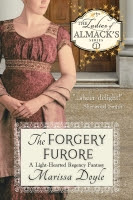What fabrics were fashionable in August 1809? Let’s have a look!
As I have in previous posts on Regency fabrics, I’m looking at actual fabric samples glued into several earlier editions of Ackermann’s Repository, samples supplied by the manufacturers and published by Ackermann in order to boost the British cloth-making industry at a time when exporting British goods to Europe was almost impossible because of the Napoleonic war. I'll give you a close-up scan of each sample, the published description if available, and my own observations of the color, weight, condition, and similarity to present-day materials, to give you as close a picture as possible of what these fabrics are like.
Four fabrics are up for August. Their overall condition is good, apart from some foxing in sample No. 4 (the brown spotting you can see on the white stripes.)
No. 1 exhibits a specimen of that elegant manufacture styled the Irish net, and is particularly well adapted for the dinner and evening dress. The silvery lightness of its texture renders it a most graceful and becoming article in this style of decoration. French cloaks, tippets, and scarfs, with small jockey or poke bonnets to correspond, with variegated green, purple, or grey feathers, have a most light and attractive effect, where formed of this material. It is sold by Mr. George, silk-manufacturer, 19, Holywell-street, Strand, at 6s. per yard, and is half-yard wide.
My comments: This is very aptly called “net” as the weave is quite open, and it would make a lovely scarf. The threads are fine and even, and there is a faint sheen to the fabric. It reminds me almost of the silk gauze used for balloons and parachutes!
No. 2 is another article of new and fashionable adoption, styled Merino crepe, and is calculated also for ladies’ dresses, but in the more intermediate order of personal decoration. The blending of its shades, and its union of silk and worsted, give a sort of distinguishing character to this tasteful article, and render it most appropriate for the approaching autumnal months, when we may venture to pronounce it will be in much fashionable request. Venetian binding and imperial ribbon of the same shades, will be found the most advantageous trimmings for robes formed of this material. It is three-quarters wide, and is sold by the above manufacturer at 5s. per yard.
My comments: The blending of shades mention above are pink (the silk warp) and tan (the woolen weft). The texture is slightly rough and the fabric opaque, thought I expected that it is lightweight enough that it would drape well.
No. 3, the Andalusian washing silk, an article for robes and pelisses, comprising much delicacy of shade and figure, as well as a graceful adhesiveness of quality. Thread lace, in scallop or Vandyke, the Chinese floss trimming, or appliquéd lace beading, are the most tasteful and appropriate embellishments which this pleasing article can admit of. It is three-quarters wide, and 4s. per yard, and is furnished by Messrs. Richards and Co., 37, Oxford-street.
My comments: This is very pretty fabric, light in weight but not see-through, and with a woven diamond pattern reminiscent of dragon scales. It's very smooth and has a soft sheen, and would indeed make a lovely dress.
No. 4 is a printed diamond Marcella quilting, for gentlemen’s waistcoats. On this article there is little need of comment, except to call the attention of our readers to the peculiar delicacy of the printed stripe, which has perhaps rendered it so universal a favourite with men of high fashion. It is three-quarters wide, and from 9s. to 10s. per yard, and is furnished by Messrs. R. Smith and Co. 2 Prince’s-street, Leicester-square.
My comments: We've seen these heavy quilted fabrics for men's waistcoats here and here; this one has a very clear diamond-patterned quilted effect, though it is not actually quilted but woven in. I always find myself envisioning men’s waistcoats from this era as being dark in color, but so far, all the fabrics we’ve seen described as appropriate for waistcoats have been light in color.
Subscribe to:
Post Comments (Atom)










1 comment:
I appreciate you taking the time to scan and describe these fabrics.
Post a Comment